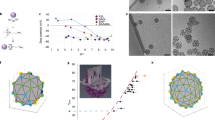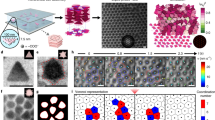Abstract
Self-assembled mesoporous structures with well-ordered nanoscale channels could be used in applications such as molecular separation, nano-optics, molecular electronics, nanomedicine and catalysis1,2,3,4,5,6,7. However, the domain sizes that can be created in such systems are limited by our lack of a detailed understanding of the relevant growth processes8,9,10,11,12. Here we report the real-time observation of domain growth in the self-assembly of silica nanochannels using fluorescence polarization imaging and atomic force microscopy. We show that transient lamellar structures precede the formation of hexagonal layers, and that the layer growth follows two distinct pathways. In addition, the domains are grown on a mesoporous film substrate, which acts as a sieve and allows control of the delivery of the reactive species. We use these insights and capabilities to grow layers of well-ordered silica nanochannels with domain sizes of up to ∼0.3 mm.
This is a preview of subscription content, access via your institution
Access options
Subscribe to this journal
Receive 12 print issues and online access
$259.00 per year
only $21.58 per issue
Buy this article
- Purchase on Springer Link
- Instant access to full article PDF
Prices may be subject to local taxes which are calculated during checkout



Similar content being viewed by others
References
Davis, M. E. Ordered porous materials for emerging applications. Nature 417, 813–821 (2002).
Grosso, D. et al. Periodically ordered nanoscale islands and mesoporous films composed of nanocrystalline multimetallic oxides. Nature Mater. 3, 787–792 (2004).
Riehemann, K. et al. Nanomedicine—challenge and perspectives. Angew. Chem. Int. Ed. 48, 872–897 (2009).
Dag, Ö., Ozin, G. A., Yang, H., Reber, C. & Bussière, G. Photoluminescent silicon clusters in oriented hexagonal mesoporous silica film. Adv. Mater. 11, 474–480 (1999).
Sanchez, C., Boissiere, C., Grosso, D., Laberty, C. & Nicole, L. Design, synthesis, and properties of inorganic and hybrid thin films having periodically organized nanoporosity. Chem. Mater. 20, 682–737 (2008).
Yang, C. M., Cho, A. T., Pan, F. M., Tsai, T. G. & Chao, K. J. Spin-on mesoporous silica films with ultralow dielectric constants, ordered pore structures, and hydrophobic surfaces. Adv. Mater. 13, 1099–1102 (2001).
Chen, Z. et al. DNA translocation through an array of kinked nanopores. Nature Mater. 9, 667–675 (2010).
Grosso, D. et al. Two-dimensional hexagonal mesoporous silica thin films prepared from block copolymers: detailed characterization amd formation mechanism. Chem. Mater. 13, 1848–1856 (2001).
Grosso, D. et al. Fundamentals of mesostructuring through evaporation-induced self-assembly. Adv. Funct. Mater. 14, 309–322 (2004).
Antonietti, M. & Ozin, G. A. Promises and problems of mesoscale materials chemistry or why meso? Chem. Eur. J. 10, 28–41 (2004).
Gibaud, A. et al. Evaporation-controlled self-assembly of silica surfactant mesophases. J. Phys. Chem. B 107, 6114–6118 (2003).
Doshi, D. A. et al. Peering into the self-assembly of surfactant templated thin-film silica mesophases. J. Am. Chem. Soc. 125, 11646–11655 (2003).
Lu, Y. F. et al. Continuous formation of supported cubic and hexagonal mesoporous films by sol gel dip-coating. Nature 389, 364–368 (1997).
Yang, H., Kuperman, A., Coombs, N., MamicheAfara, S. & Ozin, G. A. Synthesis of oriented films of mesoporous silica on mica. Nature 379, 703–705 (1996).
Brinker, C. J., Lu, Y. F., Sellinger, A. & Fan, H. Y. Evaporation-induced self-assembly: nanostructures made easy. Adv. Mater. 11, 579–585 (1999).
Kirstein, J. et al. Exploration of nanostructured channel systems with single-molecule probes. Nature Mater. 6, 303–310 (2007).
Zürner, A., Kirstein, J., Döblinger, M., Bräuchle, C. & Bein, T. Visualizing single-molecule diffusion in mesoporous materials. Nature 450, 705–708 (2007).
Jung, C., Hellriegel, C., Michaelis, J. & Bräuchle, C. Single-molecule traffic in mesoporous materials: translational, orientational, and spectral dynamics. Adv. Mater. 19, 956–959 (2007).
Jung, C. et al. Diffusion of oriented single molecules with switchable mobility in networks of long unidimensional nanochannels. J. Am. Chem. Soc. 130, 1638–1648 (2008).
Tolbert, S. H., Firouzi, A., Stucky, G. D. & Chmelka, B. F. Magnetic field alignment of ordered silicate–surfactant composites and mesoporous silica. Science 278, 264–268 (1997).
Platschek, B., Petkov, N. & Bein, T. Tuning the structure and orientation of hexagonally ordered mesoporous channels in anodic alumina membrane hosts: a 2D small-angle X-ray scattering study. Angew. Chem. Int. Ed. 45, 1134–1138 (2006).
Koganti, V. R. et al. Generalized coating route to silica and titania films with orthogonally tilted cylindrical nanopore arrays. Nano Lett. 6, 2567–2570 (2006).
Yamauchi, Y. et al. Magnetically induced orientation of mesochannels in 2D-hexagonal mesoporous silica films. J. Mater. Chem. 16, 3693–3700 (2006).
Schirmeisen, A., Anczykowski, B. & Fuchs, H. in Nanotribology and Nanomechanics—An Introduction (ed. Bushan, B.) (Springer, 2005).
Holtrup, F. O. et al. Terrylenimides: new NIR fluorescent dyes. Eur. J. Chem. A 3, 219–225 (1997).
Lebold, T. et al. Tuning single-molecule dynamics in functionalized mesoporous silica. Eur. J. Chem. A 15, 1661–1672 (2009).
Pang, J. et al. Directed aerosol writing of ordered silica nanostructures on arbitrary surfaces with self-assembling inks. Small 4, 982–989 (2008).
Trau, M. et al. Microscopic patterning of orientated mesoscopic silica through guided growth. Nature 390, 674–676 (1997).
Jung, C. et al. A new photostable terrylene diimide dye for applications in single molecule studies and membrane labeling. J. Am. Chem. Soc. 128, 5283–5291 (2006).
Acknowledgements
The authors thank K. Müllen (Max Planck Institut) for kindly providing the TDI dye molecule, as well as T. Bein (LMU) for helpful discussions. This work was funded by SFB 486, SFB 749 and the Nanosystems Initiative Munich (NIM).
Author information
Authors and Affiliations
Contributions
C.J. conceived, designed and performed the experiments, analysed the data and co-wrote the paper. P.S. and M.D. designed and performed the experiments, and analysed the data. R.K. conceived the experiments. J.M. and C.B. conceived the experiments and co-wrote the paper.
Corresponding authors
Ethics declarations
Competing interests
The authors declare no competing financial interests.
Supplementary information
Supplementary information
Supplementary information (PDF 2601 kb)
Supplementary information
Supplementary movie 1 (AVI 10506 kb)
Supplementary information
Supplementary movie 2 (AVI 8918 kb)
Supplementary information
Supplementary movie 3 (AVI 12719 kb)
Supplementary information
Supplementary movie 4 (AVI 5168 kb)
Supplementary information
Supplementary movie 5 (AVI 5626 kb)
Rights and permissions
About this article
Cite this article
Jung, C., Schwaderer, P., Dethlefsen, M. et al. Visualization of the self-assembly of silica nanochannels reveals growth mechanism. Nature Nanotech 6, 87–92 (2011). https://doi.org/10.1038/nnano.2010.258
Received:
Accepted:
Published:
Issue Date:
DOI: https://doi.org/10.1038/nnano.2010.258



